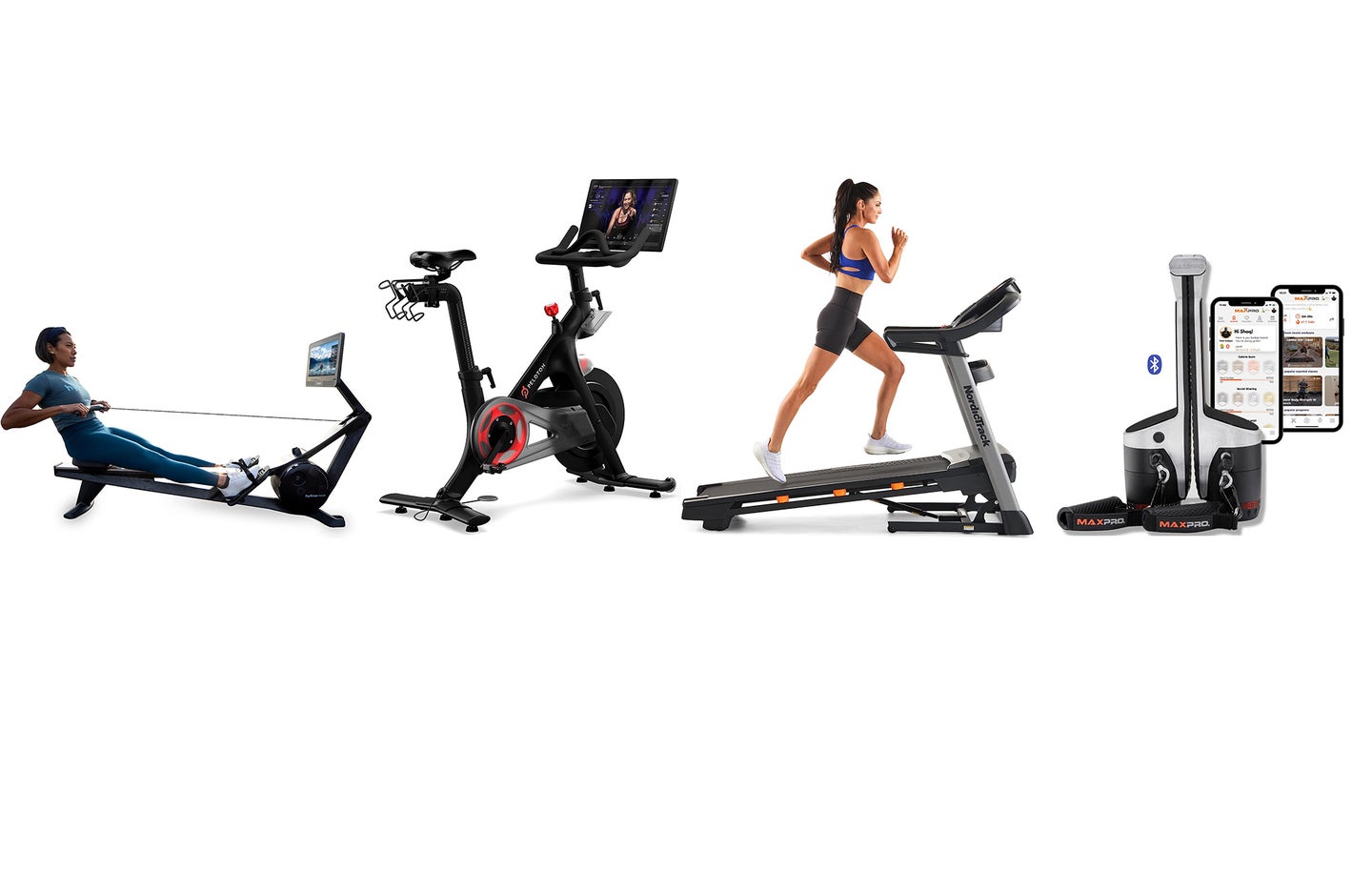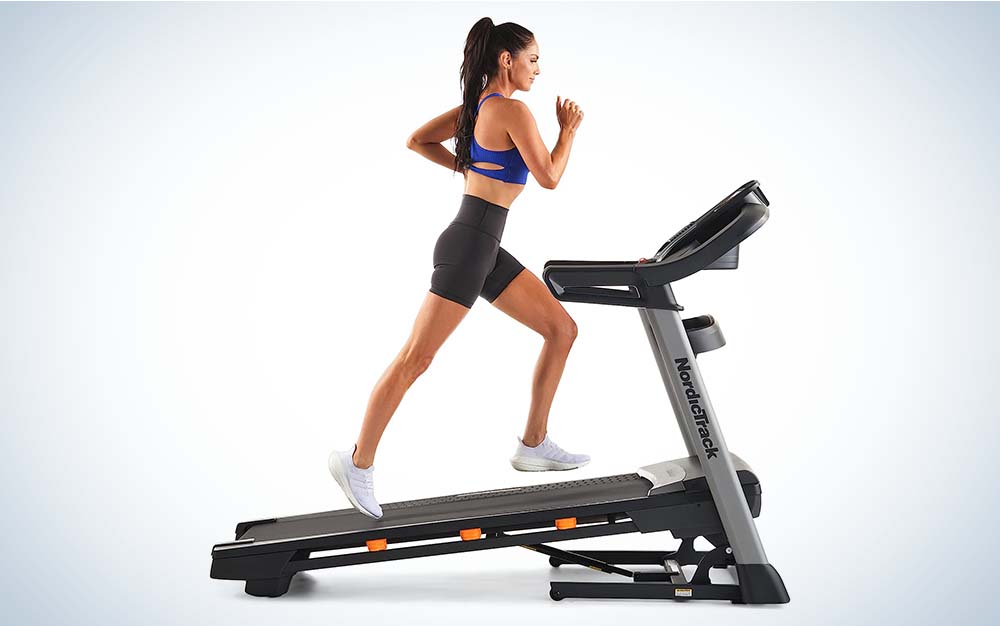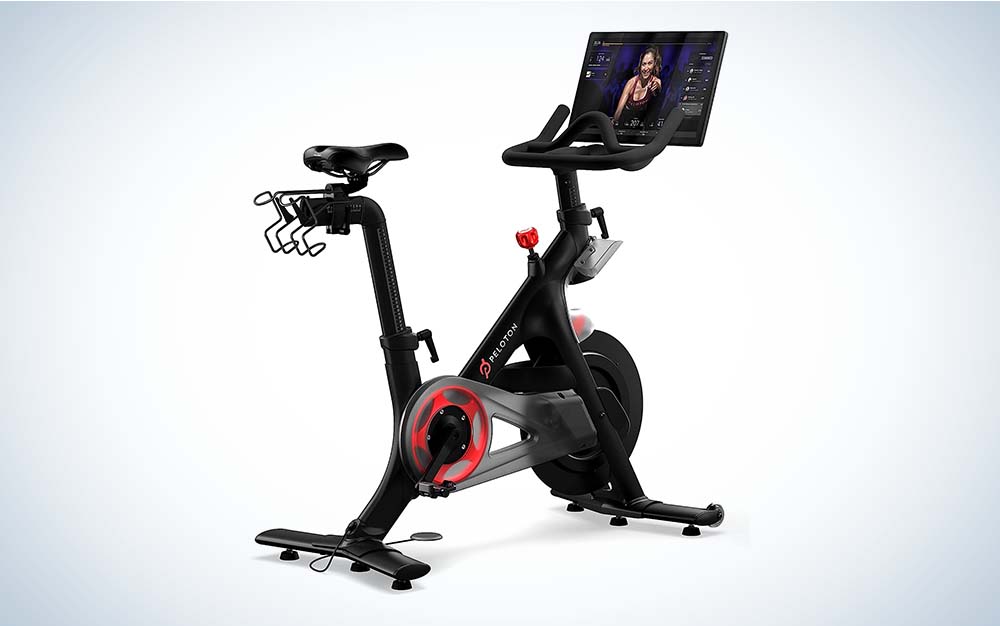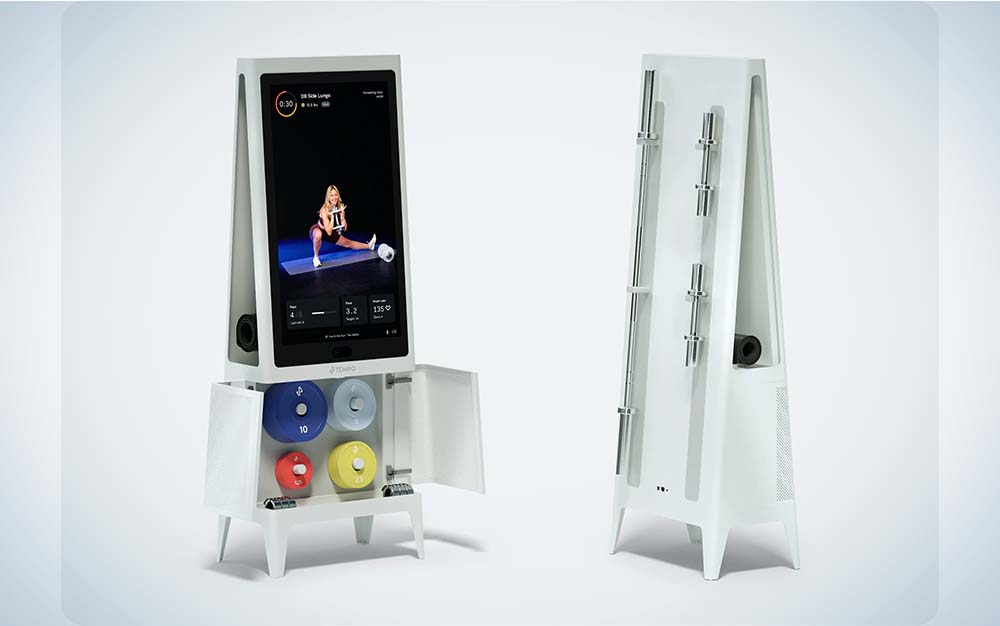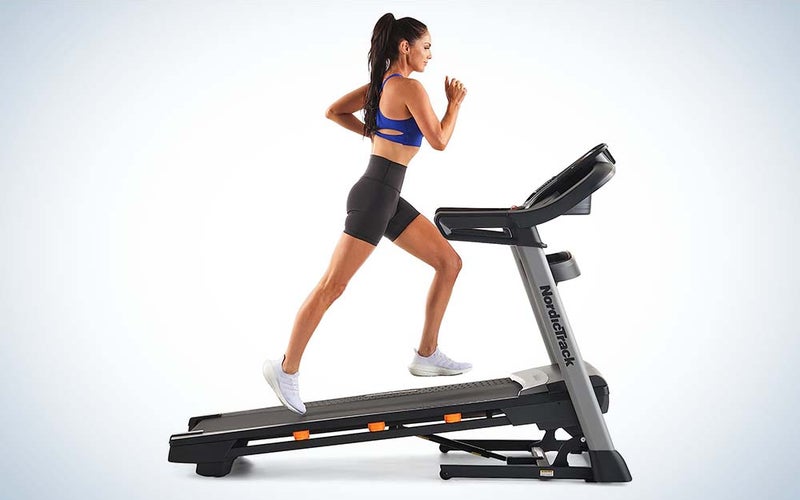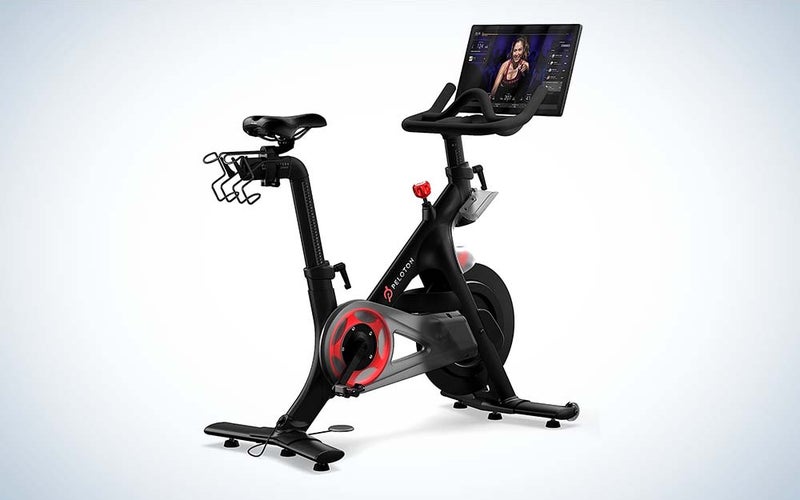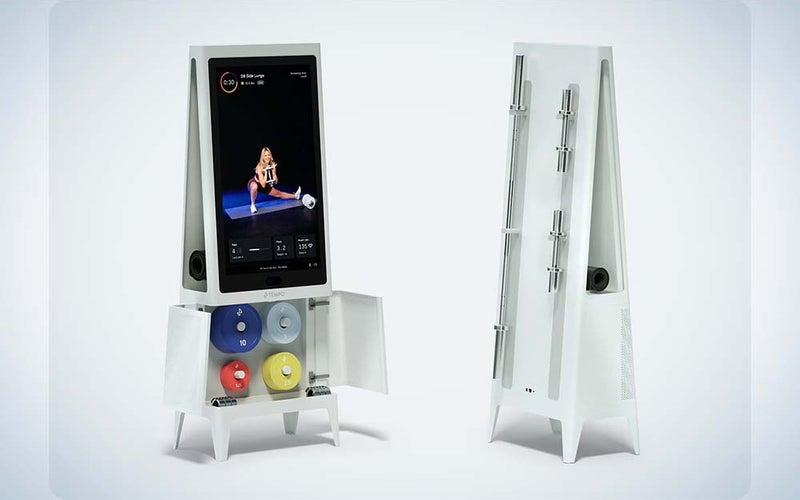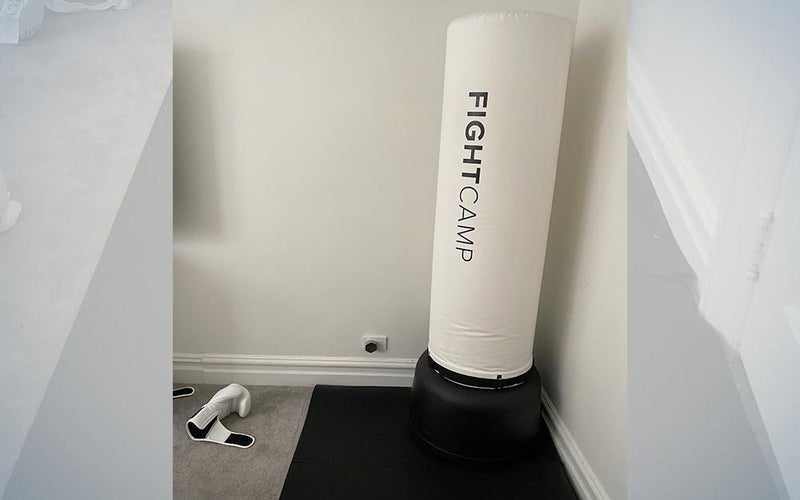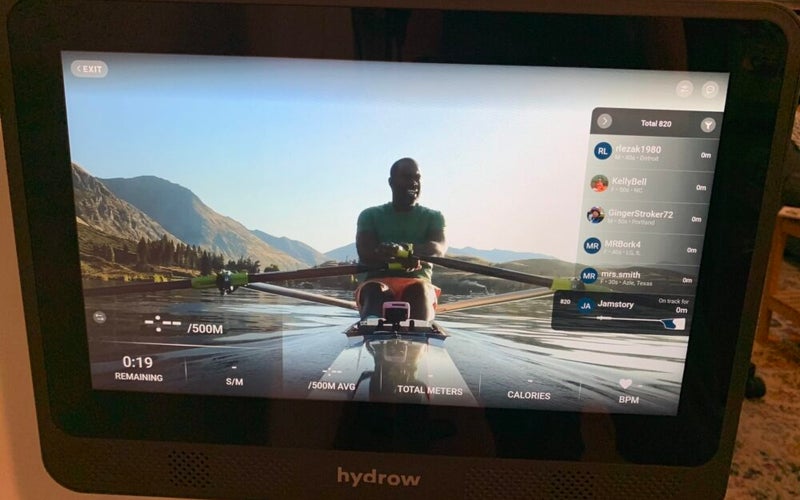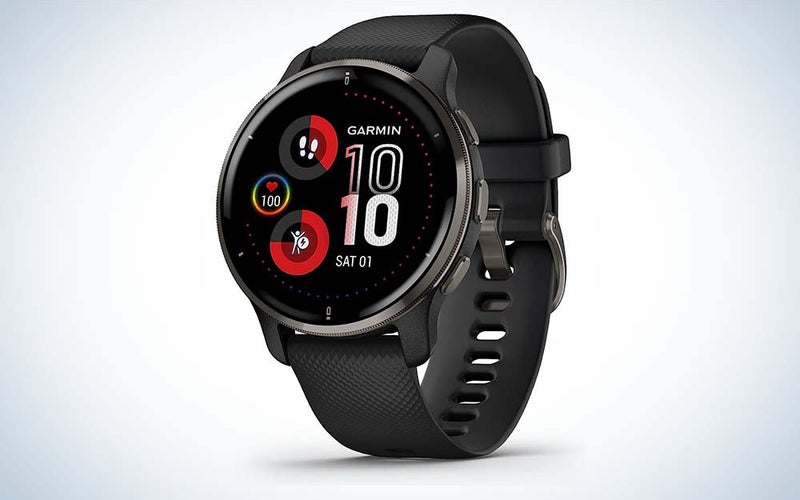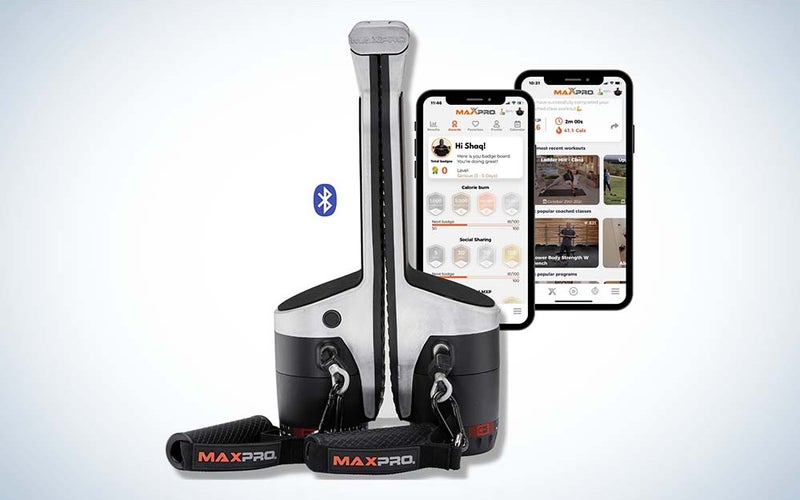We may earn revenue from the products available on this page and participate in affiliate programs. Learn more ›
Increasingly, home gyms ain’t like the setup your grandpa used. Modern equipment isn’t just about assembling an exercise circuit; it’s connected by all kinds of high-performance circuitry. It’s providing you with access to digital tools and training that are capable of refining your workout routine and truly pushing it to the next level. Below you’ll find our picks for the best smart home gyms from various realms—from treadmills to stationary bikes, plus much more. Depending on your fitness goals, any of these will deliver an outstanding experience. Pair two together, however—say by mixing a cardio machine with a weightlifting or full-body workout machine—and you’ll essentially bring home a complete gym that can deliver you everything from remote trainers to detailed metrics. To that end, here’s equipment for the best smart home gyms so that you can get your state-of-the-art sweat on.
- Best treadmill: NordicTrack T Series
- Best stationary bike: Peloton
- Best for strength training: Tempo Studio
- Best connected boxing trainer: FightCamp
- Best connected rower: Hydrow Wave Rowing Machine
- Best fitness watch: Garmin Venu 2 Plus
- Best budget: MAXPRO Fitness Cable Home Gym
How we chose the best smart home gyms
The options for working out at home are better than ever. Whether you prefer sparring, yoga, rowing, HIIT, or putting in miles on the treadmill, the best smart home gyms include equipment designed with virtual trainers and tracking to help you maximize your sweat sessions. For our list, we considered all types of activities and accessories so you can achieve the most interactive experience as you maximize your investment and output.
The best smart home gyms: Reviews & Recommendations
These days home workout equipment is getting smart. Sure, the classic versions of fitness equipment will still get the job done. Still, the best smart home gym equipment provides innovative opportunities to maximize your fitness progress and get more results in minimal time. It’s also really cool. Here are our top picks across multiple categories.
Best treadmill: NordicTrack T Series
NordicTrack
Specs
- Dimensions: 78.5 inches L x 35.5 inches W x 59 inches H
- Power: Corded
- Features: Interactive touchscreen, 12% incline
Pros
- Quiet, cushioned, smooth motion for a pleasant, safe experience
- Folds easily to save space
- Immersive touchscreen with a wide range of program options
Cons
- Must purchase a monthly membership for program access
NordicTrack has been the standard-bearer for treadmills for decades, and that’s still the case. The T Series offers pretty much everything you could want from a connected treadmill, and it does so at a surprisingly affordable price.
Available in a range of specific model packages to suit a variety of accessories needs, the most basic option provides a solid all-around treadmill with a 5-inch screen and a compact 20-inch by 50-inch deck for just shy of $700, while the top-tier includes an immersive 14-inch screen and an expansive 20-inch by 60-inch deck—and there are several other options in between. Whatever package you choose, it boasts automatic incline and speed adjustments to suit your workout program. The deck itself provides a smooth, cushioned running surface, while the motor is quiet and self-cooling. The deck can also fold to save space.
The iFIT program offers a wide range of live streams, on-demand workouts, and studio classes, and it comes with a 30-day free membership. You will have to purchase a membership after that, though the treadmill provides all its basic functions without access to classes and programs. It is recommended that you buy the expert assembly package for a hundred bucks because putting the thing together is no small task.
Best stationary bike: Peloton
Specs
- Dimensions: 59 inches D x 23 inches W x 53 inches H
- Power: Corded electric
- Features: Touchscreen, camera, stereo speaker system
Pros
- Sturdy, comfortable equipment provides an enjoyable experience
- Superior program selection for quality workouts
- Wide, immersive screen makes location courses a pleasure
Cons
- Must purchase a monthly membership for program access
There are a lot of stationary bikes on the market, and there are a few solid smart bike options, but there’s only one Peloton. It’s become so synonymous with stationary bikes that it’s almost become cliche, but the thing is, they’re really, really high quality.
First of all, the overall craftsmanship is outstanding. There are no worries about rocking back and forth like with many other bikes—Pelotons stand rock solid. Their seats are comfortable enough for long classes, the setup can be easily adjusted to suit your body size, and the pedal action is smooth. It also has a relatively compact footprint, making it a decent option for small spaces.
The Peloton programs are fantastic. Viewed via an expansive touchscreen, membership provides access to thousands of wide-ranging classes, games, location courses, and more. It even offers fitness and wellness programs beyond cycling, such as yoga, strength training, boxing, and so on. You do need a membership to get the most out of it, however. Without one, the equipment will still function as a basic stationary bike, but the classes vastly boost the experience.
Best for strength training: Tempo Studio
Tempo
Specs
- Dimensions: 72 inches H x 26 inches W x 16 inches D
- Power: Corded electric
- Features: AI creates digital personal trainer, range of packages
Pros
- Expansive screen delivers quality programming and real-time form adjustments
- Free weights, unlike most dubious home cable weight setups
- All-in-one setup boasting all the essentials
Cons
- Not for heavy lifters
There’s no shortage of smart weightlifting options on the market, but Tempo Studio stands out because it provides real-time form adjustments. While most connected strength trainers are essentially videos you follow, Tempo boasts an AI-driven element that analyzes your form and provides adjustment recommendations. It’s essentially a digital personal trainer.
Another difference: While many similar products come with cheap feeling gear, the weights and bars included with Tempo offer gym-level quality. Tempo Studio comes with three packages. Starter is limited to the screen and a pair of dumbbells. Plus, steps up to include a barbell and bench. Pro goes full package, with a folding bench, squat rack, kettlebell setup, and 215 pounds of weights. Most of the gear stores nicely in the screen platform while the benches fold flat, so the whole thing has a small footprint and eats up very little space.
The really experienced lifters out there might say that that’s not a lot of weight, and they would be somewhat right. That’s way more than the average lifter will ever need, but the top-tier bodybuilders out there will be left wanting. For typical and even somewhat advanced users, however, Tempo offers more than enough.
Best connected boxing trainer: FightCamp
Billy Cadden
Specs
- Dimensions: 67 inches H x 24 inches W
- Power: N/A
- Features: Punching bag, punch trackers, range of classes
Pros
- Fun fusion of cardio and strength training
- Classes are comprehensive and well-instructed
- Equipment is of better quality than competitors
Cons
- Heavy hitters might experience some punching bag creep
When it comes to home boxing trainers, nothing beats FightCamp, period. Not only does it offer a fun and effective fusion of cardio and strength training, but the gear looks great in your living space while taking up very little room.
FightCamp uses a set of punch trackers to collect data on your punching performance, which it gathers as you train to different fighting programs designed to teach basics, footwork, punching styles, and even kickboxing. You then use the data to improve speed and beat your own performance—or compete with other users—which delivers surprisingly solid results in terms of performance improvement.
The equipment—which includes gloves, punch trackers, and a free-standing bag—is of much better quality than other similar products. The classes are well delivered, and the experience is flat-out fun. The really heavy hitters out there might find that the punching bag creeps a bit if the base is filled with water rather than sand, but other than that, there are few faults with the system. It also comes in two fairly affordable package sizes, which makes it a great option if you’re looking for fitness gifts.
Best connected rower: Hydrow Wave Rowing Machine
Jen McCaffery
Specs
- Dimensions: 80 inches D x 19 inches W x 43 inches H
- Power: Corded electric
- Features: Touchscreen, access to more than 4,000 classes with membership
Pros
- Great full body, low impact cardio, and strength workout
- Sturdy, stable craftsmanship for comfort and durability
- Enjoyable, effective workout programs
- Easy to assemble and store
Cons
- Expensive
- Subscription required to track basic data
Rowers can provide an outstanding combination of cardio and strength exercise, but models intended for home use are often wobbly and unstable. Not so with the Hydrow Rower, which is as stable and sturdy as they come, delivering a solid combination of cardio and strength training that is low impact on your joints (as we found in our full review).
The Hydrow Rower offers thousands of workout programs to choose from to suit any fitness goal, all of which are followed via an expansive 16-inch touchscreen. The screen is bright and colorful, making the location programs that allow you to row digitally through water sites around the world visually pop. It’s also easy to assemble and folds for convenient storage.
Memberships are offered in two package tiers, with the one negative being that you must purchase a membership to track even the most basic of data like distance, calories burned, and so on. But if you’re in it for the classes anyways, this rower is unsurpassed.
Best fitness watch: Garmin Venu 2 Plus
Garmin
Specs
- Dimensions: 1.3-inch screen
- Power: Lithium polymer battery (included)
- Features: ECG, GPS, bright AMOLED display
Pros
- Wide variety of fitness activity tracking options
- Full range of smartwatch functions for managing calls, emails, notifications, etc.
- Extremely long battery life
- Looks great by every metric
Cons
- Wireless charging would be nice
A solid fitness tracker is a great tool for supporting home fitness—or fitness in any context really. And while we’ve got recommendations for the best Fitbits, when it comes to wearing a fitness watch that will truly track any and all activities, the Garmin Venu 2 Plus is as good as they get.
The Venu 2 Plus tracks almost every fitness activity imaginable, even swimming. And while tracking fitness metrics should sometimes be taken somewhat with a grain of salt—so far, there is no single device that tracks everything with total accuracy—the Garmin has been pretty extensively tested and proven to track with reasonable accuracy factors like calories burned, heart rate, SpO2 (oxygen level), skin temperature, stress, sleep, and more. Its GPS tracking for running and hiking is as accurate as can be. And it responds well as you progress through different stages of an interval training session.
On top of all that, it delivers a pretty comprehensive range of smartwatch functions, like receiving calls and notifications, listening to and controlling music, accessing your phone’s voice assistant, and a lot more. And it looks great, with a bright face that can be endlessly customized. For these and other reasons, Garmin smartwatches definitely rank highly among our best Apple Watch alternatives.
The bottom line is that few accessories can support your fitness routine in as many ways, big and small.
Best budget: MAXPRO Fitness Cable Home Gym
Maxpro
Specs
- Weight: Less than 9 pounds
- Power: Battery-powered
- Features: Digital coaching for weightlifting, sensors track your stats
Pros
- (Relatively) affordable package option
- Full-body workout with minimal equipment
- Extremely space efficient
Cons
- Doesn’t quite compare to a typical gym experience
- Some users report difficulty achieving coordinated movements
There aren’t a lot of affordable smart home gym setups on the market, at least not ones emphasizing strength training. MAXPRO, however, offers a solid full-body workout fused with digital coaching for significantly less than the competition.
The MAXPRO achieves this via a cable pulley system capable of producing between 5 and 300 pounds of resistance. The basic package comes with a pulley base that can be attached to a bench, door, or other fixed point, and then you use handles and ankle straps to exercise various muscle groups. Sensors monitor your workout, collect data to monitor your progress, and provide coaching suggestions. The whole setup weighs less than nine pounds and takes up almost no room, so it’s easy to store or pack along while traveling.
Some users report that it does take some getting used to and that it can be difficult to achieve coordinated movements between both sides of your body. But while it’s not a total replacement for a real gym, it does allow you to bring home a solid workout.
What to consider when buying the best smart home gyms
As you’ve probably realized while reading our recommendations, home fitness equipment comes in an extremely wide range of formats, meaning there are many factors to consider when selecting the right one for you. Here are some of the most important things to keep in mind.
Your fitness goals
What are you looking to get out of your fitness routine? Cardio? Strength training? Classes? Or individual workouts? Some mix of them all? You need to choose the equipment or combination of equipment that will best address your individual goals. A treadmill won’t do much for your fitness training, for example, and a strength trainer isn’t likely your best option for cardio.
Living space requirements
A home gym can be demanding in terms of your living space. Some products require more space than others, but you want something that will look good in your home long after you buy it. Choose a piece that will have a reasonable footprint relative to the available room and suit your aesthetic tastes.
Enjoyment
One of the basic tenets of fitness is that if you can’t enjoy an activity, you won’t stick to it. Choose a home gym you’ll have fun using in the long run. Some people love the repetition of lifting weights, while others need the variety and engagement of classes. Consider what’s right for your personality.
FAQs
Q: Is smart home gym equipment better than regular equipment?
That depends on you more than the equipment. For some people, old-school luddite gear will get the job done fine. But many beginners often prefer to have digital guidance, and even experienced fitness buffs can benefit from having some outside expertise. Data tracking can also be invaluable for maximizing the effectiveness of your efforts.
Q: Do all smart home gyms require a subscription?
In most cases, the smart home gym experience will be vastly expanded with a subscription. Many machines will allow you to use and track basic functions and data without it, but a key benefit to getting a piece of smart gear in the first place is that you can access the many programs and tools it offers.
Q: Can I get a good workout with a smart home gym?
That depends on the gym and on how dedicated you are to using it. Each product we’ve suggested above is 100% capable of providing an outstanding workout—if you’re willing to put in the time and effort necessary.
Q: What makes a piece of fitness equipment “smart”?
It’s kind of a vague term, but typically speaking, if a piece of equipment can be connected to the internet to access classes, live training, or other virtual fitness tools, it can wear the “smart” moniker.
Q: What do I need to have in my home before purchasing a smart gym system?
Generally speaking, just the space a particular piece of equipment requires and a somewhat stable internet connection (perhaps making it a great time to consider upgrading your Wi-Fi router). Some products will ideally require some wall space, but even that can use a stand mount if necessary.
Q: Is a smart home gym worth it?
That’s up to you. No equipment’s “smart” enough to force you to use it. You have to do that yourself. But assuming that you’re putting in the time and effort, smart gyms can offer a range of benefits to help you learn a new fitness routine or improve upon an existing one.
Final thoughts on the best smart home gyms
- Best treadmill: NordicTrack T Series
- Best stationary bike: Peloton
- Best for strength training: Tempo Studio
- Best connected boxing trainer: FightCamp
- Best connected rower: Hydrow Wave Rowing Machine
- Best fitness watch: Garmin Venu 2 Plus
- Best budget: MAXPRO Fitness Cable Home Gym
Whatever your favorite way to work out, smart equipment can enhance the experience. Whether it’s letting you train with rowers from beautiful spots around the world or setting up a sparring session or interactive yoga session, the best smart home gym equipment can help you track your progress, reach your goals, and have fun while you’re doing it.
Why trust us
Popular Science started writing about technology more than 150 years ago. There was no such thing as “gadget writing” when we published our first issue in 1872, but if there was, our mission to demystify the world of innovation for everyday readers means we would have been all over it. Here in the present, PopSci is fully committed to helping readers navigate the increasingly intimidating array of devices on the market right now.
Our writers and editors have combined decades of experience covering and reviewing consumer electronics. We each have our own obsessive specialties—from high-end audio to video games to cameras and beyond—but when we’re reviewing devices outside of our immediate wheelhouses, we do our best to seek out trustworthy voices and opinions to help guide people to the very best recommendations. We know we don’t know everything, but we’re excited to live through the analysis paralysis that internet shopping can spur so readers don’t have to.
